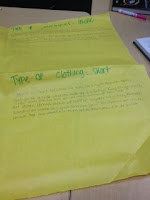





After the students created their picture they switched papers with a partner. The next step was for the students to write a definition of the word in their own words. I stressed to the students that writing the definition in their own words was vital, again this was to aid them in learning and remembering the words. The students then wrote a sentence using the word in the correct context.
Today, the students participated in a gallery walk, in which they used three column notes to create a study guide for their vocabulary quiz and to better understand the vocabulary as we study it in our current text. For the three column notes the students had to list the word in the first column, a definition in their own words in the second column, and then a picture to help them remember and connect with the word in the third column.















